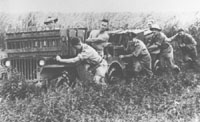


RAAF Meteorological Service
Foreword
Introduction
Chapter 1: The Weather Factor in Warfare
The Weather and Chemical Warfare
Weather Control
Chapter 2: Establishing and Developing the RAAF Directorate of Met. Services (D.Met.S)
Chapter 3: Recruiting and Training of Personnel
Chapter 4: Meteorology in Aviation
Chapter 5: The Met. Retreating
Chapter 6: The Met. Advancing
Chapter 7: The Met With the Army and the Navy
Chapter 8: Divisional Offices of the Bureau of Meteorology During the War
Chapter 9: Research and Instrumental Development
Chapter 10: The End, Aftermath, and Beyond
Appendix 1
Appendix 2
Appendix 3
Appendix 4
References
Index
Search
Help
Contact us

The Weather and Chemical Warfare (continued)
Lloyd went on:'A number of the expert personnel in the Proserpine line-up were recruited from overseas, mainly from the Porton Downs Chemical Warfare Research Station at Salisbury, UK. They included Frank Pasquill (now Dr. Frank Pasquill, FRS, recently retired from the British Meteorological Service) who was in charge of the meteorological unit, Stan Mason and Stan Crawford (civilians). The RAAF Met. component was headed by Squadron-Leader Reg Taylor, others being Don Fifer, Ronald Appleby and yours truly. The Meteorological Assistants included Sam Flett, Frank Burke, Ron Baxter, Jack Anderson, Wally Waugh, Bart Fonwood and Ray Davis.'1 was posted from Townsville to Innisfail, and still remember having to share sleeping accommodation with nine or ten civilians under very cramped conditions in the wooden cottage which constituted the unit's headquarters. My job consisted of taking frequent measurements of temperature, humidity and wind direction when gas was released in jungle sites. Wind direction was determined by the release of chlorosulphonic acid, which made a dense smoke and also burnt like blazes when it invariably spilled on one's gloved hands.'
'Most of the meteorological activity was concerned primarily with the influence of the various atmospheric elements mentioned by Don Fifer on the behaviour of air-borne gaseous and liquid particles under various conditions of terrain and vegetation. The field work was innovative, arduous; at times dangerous; sometimes conducted under simulated combat conditions, with real gas bombs dropped by a Beaufort unit based at Bowen. Several layers of impregnated safety clothing and gas masks were worn for lengthy periods during these bombing forays. Under the high temperature and humidity conditions of North Queensland, extreme bodily discomfort was the order of the day—or night!'
'Experiments conducted under less stringent conditions in the tropical rainforest around Innisfail were hampered by attacks of vast hordes of biting insects, particularly mosquitoes, against which the then popular repellents, such as citronella, were virtually useless.[11]

People in Bright Sparcs - Lloyd, Stephen Henry (Steve)
 |
Bureau of Meteorology |  |
© Online Edition Australian Science and Technology Heritage Centre and Bureau of Meteorology 2001
Published by Australian Science and Technology Heritage Centre, using the Web Academic Resource Publisher
http://www.austehc.unimelb.edu.au/fam/0217.html